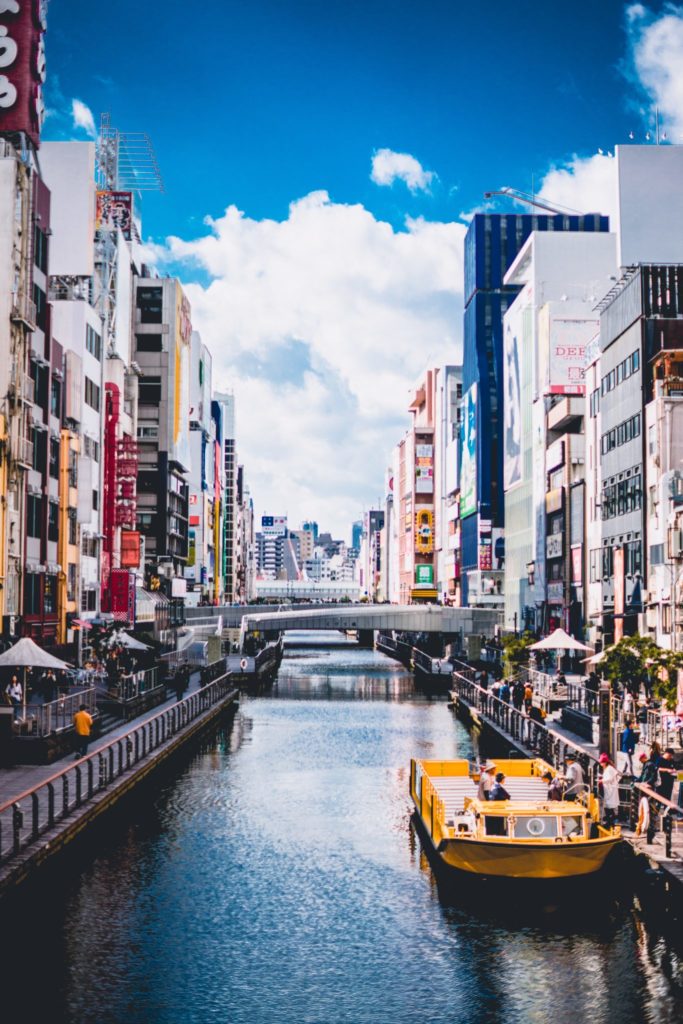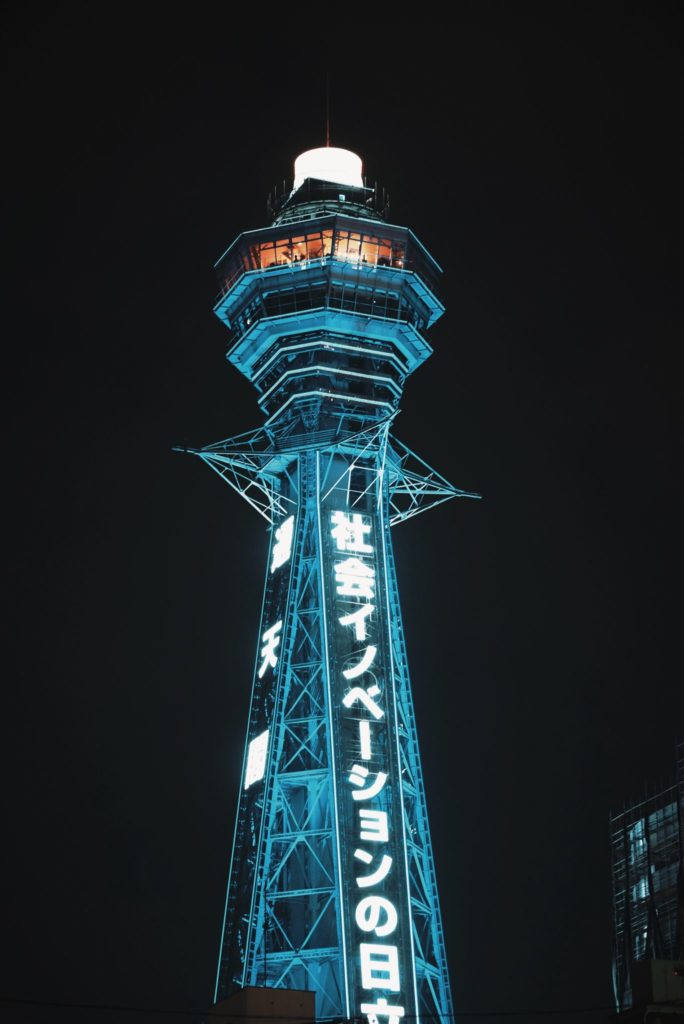Osaka is the most important city in the Kansai region. It has played a major role in Japan’s history, economy, culture, and tourism through the years.
How To Get There
Osaka is accessible via Shinkansen, plane, local train, and highway bus.
By plane, it is accessible via Kansai Airport and Itami Airport, both of which handle multiple flights to and from Tokyo, Sapporo, Fukuoka, and other cities in and outside Japan on a daily basis.
From Tokyo Station, the Shinkansen ride to Shin-Osaka Station takes three to four hours.
Travelling by local trains from Tokyo require a longer journey, about nine to ten hours, and several transfers.
By highway bus, it takes approximately eight hours to get from Tokyo to Osaka.
Top Attractions
Shitennoji Temple
Founded in the late 6th century, Shitennoji Temple is one of the oldest temples in Japan. Its complex is made up of several structures, including the spacious Gokuraku-jodo Garden, a treasure house, and a five-storied pagoda.
Sumiyoshi Taisha
Built in the 3rd century, Sumiyoshi Taisha is among Japan’s oldest and most popular shrines. It is best known for its unique architectural design, specifically the straight roofs with horizontal billets and forked finials. It consists of four main halls, and a garden with the high-arching Sorihashi Bridge over a pond.
Osaka Castle
Today’s Osaka Castle is a concrete reconstruction of the old one built in the late 16th century during the time of Japanese general Toyotomi Hideyoshi. After suffering from multiple attacks and disasters, it was rebuilt in 1931 and is currently a museum that houses a vast collection of weapons, clothing, scrolls, and other artefacts throughout the castle’s history.
The Osaka Castle Park, which grows countless cherry trees, is a popular viewing spot during peak sakura season.
Opening hours, ticket prices, access, and other information are available on Osaka Castle’s official website.
Namba
Known as Osaka’s entertainment capital, Namba is home to a wide variety of shopping, dining, and nightlife options.
Dotonbori, which is a street lined with all sorts of shops, restaurants, and eateries on both sides, is a busy area with crowds up until late in the evening. It is where you can find the huge Kani Doraku crab and the Glico Running Man signs.

Not too far is the Shinsaibashi Shopping Arcade, a 600-meter long covered shopping street that features big and small retail stores and boutiques that offer local goods and high-end designer brands. If you are more of a thrift shop shopper and into the latest teen fashion trends, Amerikamura has numerous thrift shops and stores that cater to the youth.
For fans of manga and anime, Den Den Town is a haven of stores that sell manga, figures, cosplay items, games, and electronics, as well as maid cafes.
For local history and culture enthusiasts, Namba also has the Shochikuza Theatre, which is a Western-style building that holds kabuki shows several times a year; the Kamigata Ukiyoe Museum, which has a collection of portraits of various kabuki actors on woodblock prints; the National Bunraku Theater, where you can enjoy kabuki-like, giant puppet shows; and the Hozenji Yokocho Alley, a narrow street lined with over 60 izakaya and traditional restaurants that serve Japanese cuisines.
Umeda
Umeda is one of Osaka’s busiest districts, packed with high-rise buildings, such as the Umeda Sky Building, which has a 360-degree, open air view of the city; malls and department stores, like Daimaru, Hanshin, Isetan Mitsukoshi, Yodobashi Camera, and Hankyu; restaurants, particularly in the Kitashichi District; hotels, such as the Westin Osaka Hotel; and other entertainment establishments.
There is also an underground shopping street with hundreds of stores and restaurants that provides convenient access to some department stores and train stations in the vicinity.
Shinsekai

Dubbed as the city’s “new world” district, Shinsekai possesses a number of nostalgic elements that come from the early 1900s, when Osaka was entering the start of its growth and development. The most prominent of them all is the Tsutenkaku, a 103-meter tall tower in the heart of the area, which is a popular landmark constructed in 1912 and modelled after the Eiffel Tower and the Arc de Triomphe in Paris.
Around Shinsekai, you can find many 24-hour eateries and restaurants that offer a wide selection of Japanese foods, including Osaka’s premier specialty, the kushikatsu, which is a dish made up of beef, chicken, or vegetables slathered in batter, skewered and deep fried.
Spa World, a large bath establishment with various Asian and European themed natural spring water baths, is also nearby.
Universal Studios
The Universal Studios in Osaka was constructed in 2001 and was the first of its kind in Asia. Sitting on 39 hectares of land, it features eight differently-themed sections, including The Wizarding World of Harry Potter. It offers amusement rides for all ages, from carousels for kids to heart-pumping roller coasters for grownups, snack bars and restaurants, and souvenir shops and boutiques.
Information on the park’s opening hours, ticket prices, and more are available on Universal Studios Japan’s official website.
Osaka Aquarium Kaiyukan
Situated right by the bay, Osaka Aquarium Kaiyukan is an amazing way to see some of the world’s spectacular marine life up close. Different species of fish and other animals inhabit the aquariums 15 tanks, spread out on the building’s eight storeys.
For ticket prices, opening hours, and transportation options to the aquarium, check out Osaka Aquarium Kaiyukan’s official website.
Getting Around
Osaka has several train, subway, and bus lines.
The JR West line links the downtown area to Kansai Airport, Universal Studios, and even to nearby cities like Kobe, Nara, and Kyoto.
The subway network, which includes the Midosuji, Tanimachi, Yotsubashi, and Sakaisuji Lines, can pretty much get you around the city centre.
Buses also follow routes that give easy access to some of the city’s top attractions.
Subway and bus routes, stops, fares, passes, and other information are available on Osaka Municipal Transportation Bureau’s official website.
Weather
Osaka enjoys four seasons throughout the year.
During the winter months, temperatures can dip to as low as 2 degrees Celsius, especially in its coldest month, January. In spring, the weather is generally pleasant and dry, with average daily temperatures falling between 5 and 10 degrees. In the summer, it tends to be hot and humid, with August having frequent 30+ degree-Celsius days, accompanied by rain due to typhoons that usually hit the city until early October. In autumn, the days become nicer as the temperatures start to drop to from 20 degrees in October to 10 to 15 degrees during peak autumn leaves season.
